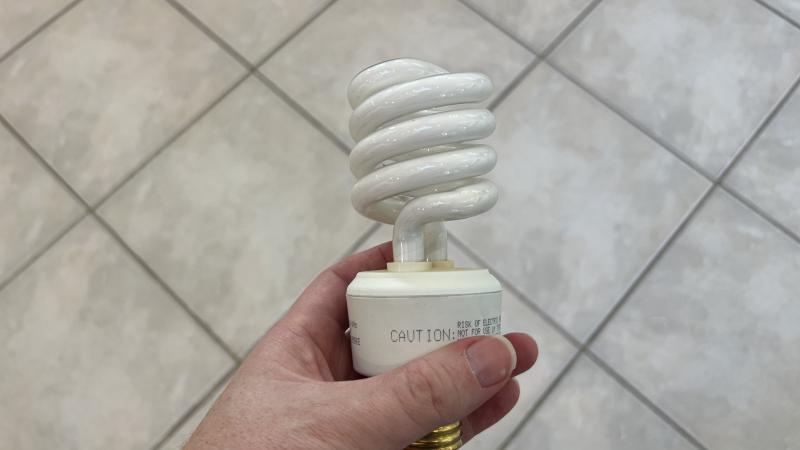Biden pursues offshore wind, but one community’s experience may offer a glimpse of what’s to come
Residents of Virginia Beach have had a number of complaints about construction noise, and some claim the developer never warned them about the visibility of the towers from the beach.
The Biden administration is charging ahead with a plan to line the nation’s coasts with offshore wind developments. The Department of the Interior announced last week a schedule of 12 offshore wind lease areas to be offered over the next five years. This includes spots in the Gulf Coast, West Coast and East Coast.
The projects that end up being built in those areas will be in addition to the projects that have already been permitted, some of which are starting construction.
Among them is Dominion Energy’s Coastal Virginia Offshore Wind, a 176-turbine project that is planned to produce 2.6 gigawatts of power. With enough wind blowing for one hour, the project could power more than 2 million homes for that one hour, but providing any households with on-demand power from intermittent wind and solar requires backup power from battery facilities, gas- or coal-fired power plants, hydroelectric facilities or nuclear power plants.
The project is in the earliest phases of construction and provides a glimpse into what other coastal communities may face as the offshore wind energy sails ahead to meet President Joe Biden’s goal of 30 gigawatts of offshore wind by 2030.
Sights and sounds
The project is being built offshore from Virginia Beach, Virginia, and residents of the community have had a number of complaints about construction noise. WAVY.com, a television website, reported that some residents of the community believe they were misled about the visibility of the towers from the beach.
In community outreach materials, including videos and public meetings, the company stated the towers wouldn’t be visible. These statements, according to WAVY.com, were based on two shorter towers the company built as a demonstration and no mention was made that the towers of Coastal Virginia would be 200 feet taller than the demonstration project.
Earlier this year, the company submitted photo simulations of what the actual project would be like to the Bureau of Ocean Energy Management as part of the permitting process, and these photos show the project barely visible along the horizon. “The citizens and us as leaders felt misled by Dominion … about the appearance of the wind turbines,” Virginia Beach Councilor Worth Remick told WAVY.com.
Other residents are also saying the construction noise onshore for infrastructure to support the turbines goes on day and night. Some residents, according to WTKR, said it’s so loud it’s caused their walls to crack.
Steve Goreham, an energy watchdog who lives part of the year in Virginia Beach, told Just The News that the turbines are pretty far off shore, and they won’t cause major impacts to the viewshed. But he said there is a lot of construction noise. He’s more concerned about the impact of renewable energy on the grid, which drives up utility bills, as well as what will happen if a hurricane blows through the area.
According to the project’s website, the turbines are built to withstand a category 2 hurricane, which have winds between 96 to 110 mph. The area was hit with two category 3 hurricanes — Hurricane Bob in 1991 and Hurricane Emily in 1993 — which have winds up to 130 mph.
Goreham said the turbines can feather, meaning they turn the blades to point into the wind to stop them from spinning too fast in high gales. “But in the middle of a hurricane, the winds change so radically and they're so powerful that I don't think they're gonna be able yaw fast enough,” Goreham said.
He said the East Coast offshore wind projects will be a test case for how turbines hold up in a hurricane. While there are many such projects in Europe, that’s well outside the Atlantic’s “hurricane alley,” which stretches from the west coast of Africa to the East Coast of the U.S.
Dominion’s response
A spokesperson for Dominion said that the company held multiple community open-house meetings from September 2023 through March 2024, which had hundreds of attendees among them. These don’t include meetings that were held in 2021 prior to filing permits applications with state authorities. He said the size and visibility of the turbines from the beach were fully communicated in these meetings.
“We made it clear very early in the process that the turbines for the CVOW [Coastal Virginia Offshore Wind] commercial project will be 800+ feet tall – more than 200 hundred feet taller than the pilot turbines,” Jeremy Slayton, spokesperson for Dominion, said in a statement emailed to Just The News.
Slayton said the commercial turbines that will be constructed could be more visible from higher elevations and at night, when the safety lights will be flashing. Those lights, he said, will use a system that will turn them on only when aircraft are in the area, and the turbine towers will be painted a light gray to help them blend in with the skyline.
“Our team is committed to transparently sharing information before construction activities begin to both make this information public and also address any remaining property owner concerns early in the process. We want neighbors to know what to expect from our work before we start,” Slayton said.
"We’ll get back to you"
Terry Johnson, who is on the board of advisors for the Committee for a Constructive Tomorrow (CFACT), told Just The News that the company hasn’t been transparent about the project.
“We've made requests to demand for a variety of information. And they either said, ‘we will get back to you,’ and haven't done so, or ‘we don't have it,’ or ‘you need to go to BOEM [Bureau of Ocean Energy Management] or to NMFS [National Marine Fisheries Service] to get it.’ They haven’t been forthcoming at all,” Johnson said.
CFACT, along with the Heartland Institute and the National Legal and Policy Center, filed a lawsuit in hopes of blocking the project, arguing that the permits didn’t properly assess the danger the project presents to whales. The same groups submitted a Freedom of Information Act request for Dominion’s species protection plan, which they say isn’t publicly available.
Energy expert Robert Bryce, in a video posted on X, showed how the areas designated for Biden’s offshore wind blitz are right on top of the highest concentrations of the endangered North Atlantic right whale. The data comes from a website that the Northeast Regional Ocean Council maintains as a public resource.
From November through June, according to the data website, an area south of Martha’s Vineyard has some of the most intense right whale activity of the entire East Coast. Just west of that area is also where multiple offshore wind projects are planned.
Johnson said the lawsuit is going to be difficult, as Dominion Energy has a lot of resources to defend against the coalition’s complaint.
“We’re David, and they’re Goliath, but sometimes David wins. So we're hoping that's the case,” Johnson said.
Protections
Slayton said the issues raised in the lawsuit have “no merit.” BOEM’s environmental review of the project was thorough and carefully considered potential impacts to marine wildlife and the environment.
“The overwhelming consensus of federal agencies and scientific organizations is that offshore wind does not adversely impact marine life. We’ve put in place strong environmental protections for this project, and are confident the North Atlantic right whale will be protected,” Slayton said.
He said the company won’t be doing any pile driving during the right whale’s migration season, and the vessels conducting the activity will be staffed with observers and equipment to detect the whales’ presence. They also have a number of vessel speed restrictions they have to adhere to.
Lastly, he said, they will also have “double big bubble curtains” that reduce the impact of the sound generated by pounding the large pylons into the sea bed. These bubble curtains are formed by hoses from which compressed air bubbles rise to the surface, forming a wall of bubbles designed to mitigate sound pressure.
However, research by acoustician Robert Rand, has found those protections to be inadequate. Rand told The Epoch Times that one possible reason the curtains are failing is because they protect sound through water but not through the seabed floor.
From 2016 through April of this year, 220 humpback whales have died, the Times reported based on data from the National Oceanic and Atmospheric Administration. The administration also reported 126 North Atlantic right whales have died since 2017, which it reports is an “unusual mortality event.”
Bryce, in his video, said that if a presidential administration had said it was going to build a string of offshore oil and gas platforms on top of major whale habitat, the reaction from activists and the media would likely be different.
In fact, when the industry threatening whales in 2023 was oil and gas, activists and the legacy media mobilized to try and stop Gulf projects that they said would threaten the endangered Rice whales, of which only about 50 remain.
In November, a federal appeals court dismissed the effort to restrict Gulf drilling to protect the whales.
“It’s clear that drilling in the Gulf means losing marine life. Animals such as the endangered Rice’s whale deserve to live in waters free from the oil, debris, and vessel strikes that are an inevitable byproduct of offshore drilling. New leases continue to put them at risk,” Luke Metzger, executive director of Environment Texas, said in a statement.
While local environmental groups have raised concerns and held protests against offshore wind development, so far, none of the major environmental groups issued statements in opposition of the Biden administration’s announcement of 12 offshore wind lease areas.
If the experience of Virginia Beach residents is any indication of what’s to come, it’s likely that coastal communities across the U.S. will be impacted by an unprecedented industrialization of the nation’s coasts. Whether the whales will be able to navigate these changing waters remains to be seen.
“For some reason, because it’s offshore wind, they’re saying, ‘Oh, no problem. This won’t affect the whales at all,’” Bryce said.
The Facts Inside Our Reporter's Notebook
Links
- Coastal Virginia Offshore Wind
- more than 2 million homes
- 30 gigawatts of offshore wind by 2030
- misled about the visibility
- caused their walls to crack
- Steve Goreham
- which drives up utility bills
- According to the projectâs website
- winds between 96 to 110 mph
- Hurricane Bob in 1991 and Hurricane Emily in 1993
- multiple community open-house meetings
- filed a lawsuit
- submitted a Freedom of Information Act request
- in a video posted on X
- from a website
- according to the data website
- research by acoustician Robert Rand
- Rand told
- The Epoch Times
- in his video
- activists and the legacy media mobilized
- dismissed the effort to restrict Gulf drilling
- said in a statement
- local environmental groups
















